Anecdotal evidence has long suggested that certain animals can predict natural disasters, detect disease and more, and now science is proving many of these stories to be correct.
Close observation of such animals could even help people to plan well in advance of coming problems, suggests a new paper in the latest issue of the journal
Current Biology.
Henry Streby of the University of California, Berkeley, and his colleagues discovered that golden-winged warblers take off from their expected locations more than 24 hours before storms hit. In this case, the storm in question produced tornadoes that killed at least 35 people.
"The most curious finding is that the birds left long before the storm arrived," said Streby. "At the same time that meteorologists on The Weather Channel were telling us this storm was headed in our direction, the birds were apparently already packing their bags and evacuating the area."
Comment: The idea that animals can predict earthquakes has ancient origins. In 373BC, the Greek historian Thucydides recorded that rats, dogs, snakes and weasels deserted the city of Helice in droves a few days before a catastrophic earthquake.
On the morning of December 26, 2004, Thai villagers noticed that buffalo grazing on the beach lifted their heads, pricked their ears and looked out to sea, then stampeded to the top of a nearby hill. For the villagers who chose to follow them, it was a live-saving move as the tsunami struck only minutes later. There have been hundreds of reports of animals seemingly foretelling catastrophe, sometimes hours and even days before it occurred. These include tales of bizarre behavior by wild beasts including elephants, antelopes, bats, rats and flamingos, plus stories of dogs refusing to go for their usual morning walk.

© Tuoi TreA Quang Ngai resident is shown holding a green snake he has killed.
Dozens of people in Da Nang City, as well as Quang Nam and Quang Ngai Provinces, have been hospitalized recently after being bitten by the poisonous reptile 'rắn lục' (green snake), with the scientific name of
Trimeresurus albolabris.
The snake perfectly disguises itself around trees thanks to its green body. It is yellow or pale green below the eyes, while its belly is green, yellowish or white, and the end of the tail is brown or red.
The situation has reached such a dangerous level that the Department of Forest Management of Quang Ngai has asked local authorities to urgently begin a campaign to drive the animals out of local neighborhoods.
Mystery surrounds the death of thousands of pigeons on the Bhimeshwor temple premises in the past week.
According to the people in Dolakha Bazaar, dead pigeons are lying on the streets, rooftops, gardens and paddy fields. The stench from dead birds pollutes the atmosphere.
"Approximately 5,000 pigeons have died in a week," said Bharat Shrestha, treasurer of the Bhimeshwor temple prayer and trust management committee.
Authorities are yet to respond to the situation.
Vets said an unidentified virus may be responsible for the menace while the locals have got into a panic fearing a disease outbreak in humans."Such cases happened in the past
but the damage this time is terrible," said temple caretaker Kashi Narayan Shrestha. He added that rooftops and areas surrounding the temple had yet to be cleared of dead pigeons.
Chris Clarke
kcet.orgFri, 19 Dec 2014 13:36 UTC

© Wyoming Jackrabbit/Flickr/Creative Commons LicenseWind turbines near Medicine Bow, Wyoming
A Portland-based wind energy company that recently
sued the federal government to keep its bird death data secret has been convicted in federal court over deaths of protected birds at two of its wind facilities in Wyoming.
The carcasses of 38 golden eagles were found at PacifiCorp Energy's "Seven Mile Hill" and "Glenrock/Rolling Hills" installations in Carbon and Converse counties between 2009 and this year, along with 336 other birds protected under the Migratory Bird Treaty Act. According to the U.S. Fish and Wildlife Service, PacificCorp disregarded risk to eagles and other birds when it built its turbines at the two facilities."PacifiCorp Energy built two of its Wyoming wind projects in a manner it knew would likely result in the deaths of eagles and other protected birds," said Sam Hirsch, the U.S Department of Justice's Acting Assistant Attorney General for Environment and Natural Resources.
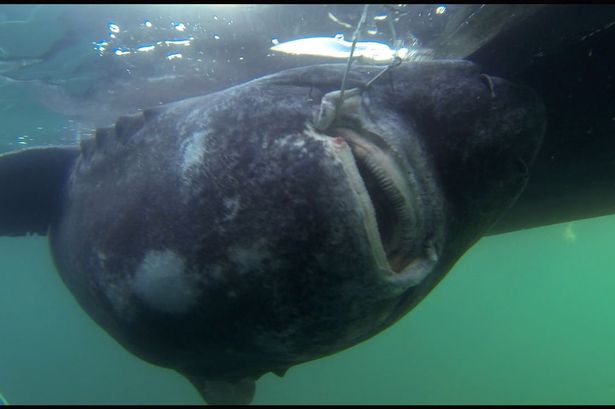
© FreeWaterPictures/BNPSCatch of the day: Angler Joel Abrahamsson reeled in the huge beast
An angler who built up his strength by reeling in blocks of concrete caught a record-breaking 89-stone shark.
Builder Joel Abrahamsson, 33, caught the 15ft Greenland while fishing off Norway.
The monster catch is a world record for a fish caught on rod and reel from a kayak.
Joel built up his strength for the record attempt by lifting rocks and practiced his technique by lowering 60lbs cement blocks into his local lake and then reeling them in.
To give him the extra power needed to reel in the 1,247lbs shark, he strapped himself into a harness that was attached to his rod, meaning if the shark had overpowered him, he could have been pulled into the freezing waters.
BBCWed, 17 Dec 2014 22:43 UTC
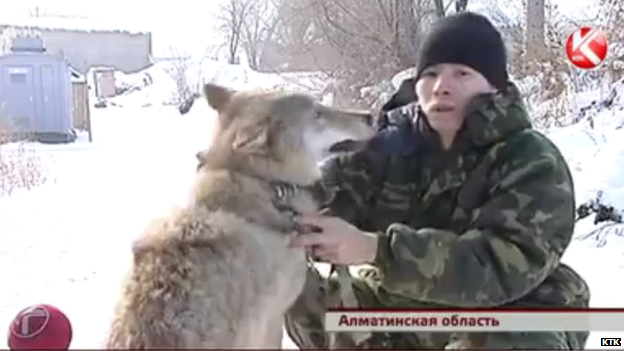
Mr Zhylkyshybay says he takes his wolf, Kurtka, for walks through the village
"You can buy a wolf cub for just $500 (£320), they say, and hunters are adamant that if treated well the wild animal can be tamed," the
KTK television channel reports. Nurseit Zhylkyshybay, from the south-eastern Almaty region, tells the channel he bought a wolf cub, Kurtka, from hunters three years ago, and the animal is perfectly happy wandering the yard of his house. "He's never muzzled, I rarely put him on a chain and do take him for regular walks around the village. Our family and neighbours aren't scared of him at all," Mr Zhylkyshybay insists. "If the wolf is well fed and cared for, he won't attack you, although he does eat a lot more than a dog."
Brian Wiechert
wect.comFri, 19 Dec 2014 22:27 UTC
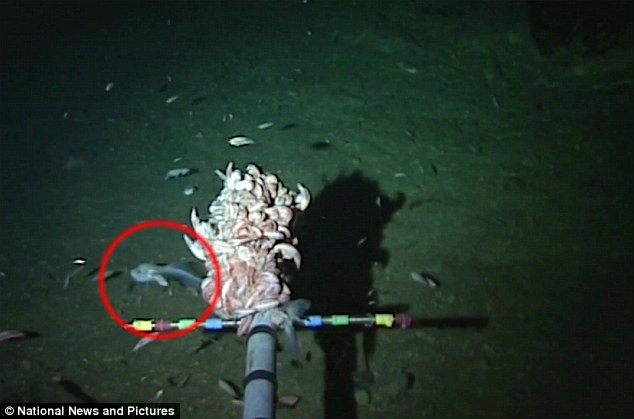
© National News and PicturesAberdeen University researchers have set a new record for the deepest fish ever found (shown in red ring)
A never-before-seen fish has been caught on camera, setting a new depth record in the Pacific Ocean.
The world's deepest fish was captured on camera at depths of 8,145 meters (26,700 feet) in the Mariana Trench in the western Pacific Ocean. The newest discovery breaks a depth record set in 2008 by nearly 500 meters (1,640 feet).
The previously unknown creature, believed to be a snailfish, was filmed several times floating along the sea floor. It is a white translucent fish with an eel-like tail and wing-like fins.
If you have a passion for birds or even if you're so-so about them, you're going to love this.
All the indicators are present telling us this year is going to be witness to another snowy owl eruption across the upper United States. That means for us up here on the Range, too!
Last year, 2013-2014, we saw what was possibly the largest eruption of snowy owls during the last century. This year could be even better. There have already been 44 snowy owls reported in Minnesota alone.There are different theories on why Snowy Owls leave the Arctic. Some believe that due to such great nesting success, a shortage of food forces the younger owls to leave the area in search of better hunting territories. Others believe the younger owls leave because they have not perfected their hunting skills yet and would not be able to survive competing among older, wiser owls. No matter the reason, what this really means to most of us is this will be a great winter to get out and see one of these beautiful visitors from the Arctic Tundra.
Paula Tracy
wmur.comFri, 19 Dec 2014 20:50 UTC
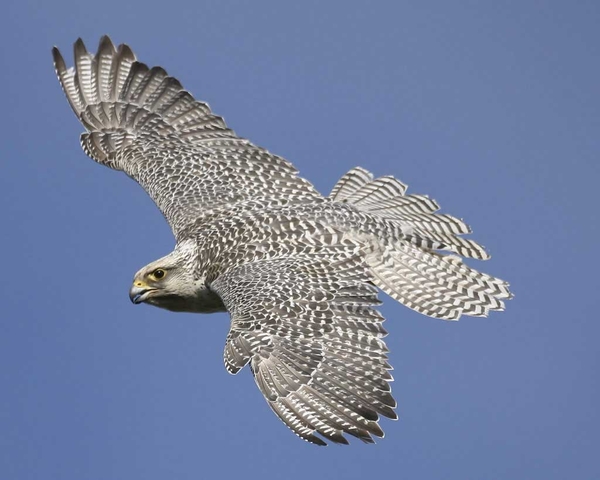
© Hanne & Jens Eriksen/VIREO
The largest of the falcons, a rare gyrfalcon, was seen in Madbury during the past week, according to the Audubon Society's rare bird alert.
Fast like a peregrine falcon and wearing a faint mustache, gyrfalcons live in the Arctic.
According to the Peregrine Fund, the birds of prey are very sensitive to changes in the environment.
The group said pesticides, loss of habitat or a decrease in prey can affect populations of gyrfalcons.
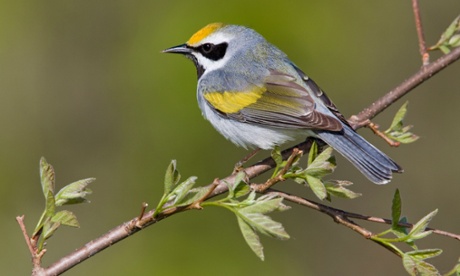
© AlamyThe golden-winged warblers may have picked up infrasound from tornadoes, which travels through the ground.
A group of songbirds may have avoided a devastating storm by fleeing their US breeding grounds after detecting telltale infrasound waves.
Researchers noticed the behaviour after analysing trackers attached to the birds to study their migration patterns.
They believe it is the first documented case of birds making detours to avoid destructive weather systems on the basis of infrasound.The golden-winged warblers had just returned from South America to their breeding grounds in the mountains of Tennessee in 2013 when a massive storm was edging closer. Although the birds had just completed a migration of more than 2,500km, they still had the energy to evade the danger.
The storm, which spawned more than 80 tornadoes across the US and killed 35 people,
was 900km away when the birds, apparently acting independently of one another, fled south, with one bird embarking on a 1,500km flight to Cuba before making the return trip once the storm had passed.


Comment: The idea that animals can predict earthquakes has ancient origins. In 373BC, the Greek historian Thucydides recorded that rats, dogs, snakes and weasels deserted the city of Helice in droves a few days before a catastrophic earthquake.
On the morning of December 26, 2004, Thai villagers noticed that buffalo grazing on the beach lifted their heads, pricked their ears and looked out to sea, then stampeded to the top of a nearby hill. For the villagers who chose to follow them, it was a live-saving move as the tsunami struck only minutes later. There have been hundreds of reports of animals seemingly foretelling catastrophe, sometimes hours and even days before it occurred. These include tales of bizarre behavior by wild beasts including elephants, antelopes, bats, rats and flamingos, plus stories of dogs refusing to go for their usual morning walk.